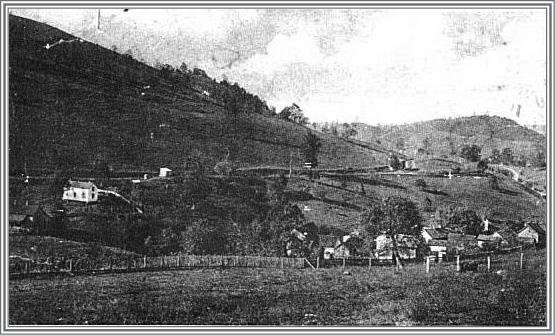Gabriel's Journey (14 page)
Authors: Alison Hart

The town of Saltville was the scene of a fierce battle between the North and the South. During the Civil War, the troops needed salt for many purposes. It was used for tanning leather shoes, harnesses, holsters, and saddles. Horses required salt in their diet. And since there was no refrigeration, beef and pork were salted to be preserved as food for the troops.
The Saltville mines and saltworks were major suppliers of salt for the Confederate armies. The Saltville pots were kept boiling throughout the war, manned by slaves twenty-four hours a day. The mines and saltworks produced thousands of bushels of salt every day.
On October 2, 1864, 5,200 Union soldiers from Eastern Kentucky and Camp Nelson, including the newly formed Fifth U.S. Colored Cavalry, attacked Saltville. The day-long fight was a Confederate victory. Many of the Union soldiers were killed, wounded, or captured.
During the Civil War the North and the South agreed to rules stating that captured soldiers were to be held as prisoners of war. When the war ended, the prisoners would be exchanged. However, the Confederate army considered black soldiers as runaway slaves. They also labeled the white officers who commanded black soldiersâlike Captain Waiteâas criminals because they were helping the “runaways.” Jefferson Davis, President of the Confederate States of America, sent out a proclamation declaring that captured officers of black regiments were to be “put to death or be otherwise punished” and the men serving under them were to be hanged or returned to slavery.

Following the battle of Saltville, Confederate troops killed a number of wounded and captured black troops after they had surrendered. According to oral history, the bodies were buried in a nearby sinkhole. Historians disagree on the number of black soldiers “missing in action” after this battle. Estimates range from a dozen to one hundred and fifty. The killings later came to be known as the “Saltville Massacre.”
When Confederate General Robert E. Lee heard of the massacre, he declared that the officers responsible should be arrested and brought to trial. It wasn't until the war was over that a Confederate guerrilla fighter named Champ Ferguson was arrested and charged with murdering fifty-three soldiers. While he was not convicted of killing the black soldiers, he was found guilty of robbery and murder. Ferguson was hanged in October 20, 1865, slightly over a year after the battle of Saltville.
Each year on October 2, a dedication and memorial service is held at the Saltville Battleground to honor the black soldiers who died in 1864.
Note:
The quotes from Reverend John G. Fee were obtained from
Camp Nelson, Kentucky.
The quote from Elijah Marrs came from
Life and History of Elijah P. Marrs.
The quote from Colonel James S. Brisbin was found in
The War of the Rebellion: A Compilation of the Official Records of the Union and Confederate Armies,
Series I, Vol. XXXIX. Government Printing Office, Washington: 1892. The quote from Jefferson Davis appears in
Till Victory is Won.
The quote from Major Jennens is from “The Expendable Horse in the Civil War.”
Special thanks to Robert A. Niepert, Civil War re-enactor and cavalryman, Lieutenant Colonel 3rd Battalion, Hardy's Brigade, Florida; Dr. Stephen McBride, Director of Interpretation and Archaeology, Camp Nelson Civil War Heritage Park; and David Brown, whose great-great-grandfather Samuel Truehart was a soldier in the Fifth United States Colored Cavalry.
T
O RESEARCH AND WRITE
G
ABRIEL'S
J
OURNEY
, I read many books, articles, and online information. The following sources were especially helpful:
OOKS
- Cooke, Philip St. George.
The 1862 U.S. Cavalry Tactics.
Stackpole Books, PA: 2004. - Higginson, Thomas Wentworth.
Army Life in a Black Regiment.
Corner House Publishers, Massachusetts: 1971. - Kent, William B.
A History of Saltville.
Commonwealth Press, Inc. Radford, Virginia: 1955. - Lucas, Marion B.
A History of Blacks in Kentucky: From Slavery to Segregation, 1760â1891.
Kentucky Historical Society: 2003. - Lucas, Scott J. “High Expectations: African Americans in Civil War Kentucky.”
Negro History Bulletin:
Jan/Dec. 2001. - Marrs, Elijah P.
Life and History of the Reverend Elijah P. Marrs.
Louisville, KY: 1885. - Marvel, William.
The Battles for Saltville.
H. E. Howard, Inc., Lynchburg, VA: 1992. - Mays, Thomas D.
The Saltville Massacre.
Ryan Place Publishers, Inc. Fort Worth, TX: 1995. - Mettger, Zak.
Till Victory is Won: Black Soldiers in the Civil War.
Puffin: 1997. - Miller, Francis Trevelyan.
The Cavalry: The Photographic History of the Civil War.
Castle Books, New York: 1957. - Murphy, Jim.
The Boys' War: Confederate and Union Soldiers Talk about the Civil War.
Clarion Books, New York: 1990. - Niepert, Robert A. “The Expendable Horse in the Civil War.”
www.floridareenactorsonline.com - Niepert, Robert. A. “The Cavalryman's Accoutrements.”
www.floridareenactorsonline.com - Ray, Delia.
Behind the Blue and Gray: The Soldier's Life in the Civil War.
Puffin: 1996. - Sears, Richard D.
Camp Nelson, Kentucky: A Civil War History.
The University Press of Kentucky: 2002. - Smith, John David, ed.
Black Soldiers in Blue: African American Troops in the Civil War Era.
University of North Carolina Press: 2002. - Wilson, Keith P.
Campfires of Freedom: The Camp Life of Black Soldiers during the Civil War.
The Kent State University Press, Ohio: 2002.
EBSITES
- www.campnelson.org
- http://mywebpages.comcast.net/5thuscc/index.htm
(This is the website of David Brown, whose great grandÂfather was Samuel Truehart, a Kentuckian who mustered in at Camp Nelson on September 12, 1864, and was placed in Company E of the Fifth Colored Cavalry. Brown has carefully researched the battle and its aftermath.) - www.saltville.com
- www.vahistory.org
“The Horse: A Silent Hero of Our History”
The following books will help you learn more about a soldier's life during the Civil War:
- Black, Wallace B.
Slaves to Soldiers: African-American Fighting Men in the Civil War.
Franklin Watts, NY: 1998. - Brooks, Victor.
African Americans in the Civil War.
Chelsea House Publishers, Philadelphia: 2000. - Corrick, James A.
Life among the Soldiers and Cavalry.
Lucent Books, Inc., CA: 2000. - Ford, Carin T.
African American Soldiers in the Civil War.
Enslow Publishers, Inc., NJ: 2004. - Mettger, Zak.
Till Victory is Won: Black Soldiers in the Civil War.
Puffin: 1997. - Wisler, G. Clifton.
When Johnny Went Marching: Young Americans Fight the Civil War.
HarperCollins, NY: 2001.

ALISON HART
enjoys writing about history and horses, two of her favorite subjects. “I'd love to go back in time,” she says, “and meet people like Gabriel who followed their dreams, no matter what the hardships.” Researching G
ABRIEL'S
H
ORSES
took her to the Bluegrass region of Kentucky and its rich Thoroughbred racing and Civil War history. She soon realized that the suspenseful story of Gabriel and his family wouldn't fit in one book. The result was the Racing to Freedom trilogy: G
ABRIEL'S
H
ORSES
, G
ABRIEL'S
T
RIUMPH
, and G
ABRIEL'S
J
OURNEY
.
Ms. Hart, a teacher and author, has written more than twenty books for children and young adults. Many of her titlesâincluding A
NNA'S
B
LIZZARD
, an
IRA
Teacher's Choice and
WILLA
Finalist, and S
HADOW
H
ORSE
, an Edgar Nomineeâfeature horses. Her historical mystery F
IRES OF
J
UBILEE
is also set at the time of the Civil War.

Published by
PEACHTREE PUBLISHERS
1700 Chattahoochee Avenue
Atlanta, Georgia 30318-2112
Text © 2007 by Alison Hart
All rights reserved. No part of this publication may be reproduced, stored in a retrieval system, or transmitted in any form or by any meansâelectronic, mechanical, photocopy, recording, or any otherâexcept for brief quotations in printed reviews, without the prior permission of the publisher.
Cover design by Loraine M. Joyner
Print book design by Melanie McMahon Ives
Photo credits:
Sergeant William H. Carney
,
Union officers with “contrabands”
,
Civil War recruitment poster
,
Troops filling canteens
, and
Colored school at Camp Nelson
courtesy of the Library of Congress
The Library of Congress has cataloged the print editions as follows:
Hart, Alison, 1950-
  Gabriel's journey / by Alison Hart.â 1st ed.
      p. cm.
  Summary: Thirteen-year-old Gabriel, a former slave, leaves behind his life as a professional jockey and joins his father in the Fifth U.S. Colored Cavalry at Camp Nelson, Kentucky.
  ISBN-13: 978-1-56145-442-6 / ISBN-10: 1-56145-442-7
  ISBN-13: 978-1-56145-530-0 / ISBN-10: 1-56145-533-X
 1.  United StatesâHistoryâCivil War, 1861â1865âJuvenile fiction. [1. United StatesâHistoryâCivil War, 1861-1865âFiction. 2. SoldiersâFiction. 3. HorsesâFiction. 4. African AmericansâFiction. 5. FreedmenâFiction. 6. United States. Army. CavalryâFiction. 7. Camp Nelson (Ky.)âHistoryâ19th centuryâFiction. 8. KentuckyâHistoryâCivil War, 1861â1865âFiction.]  I. Title.
  PZ7.H256272Gac 2008
  [Fic]âdc22
                                                           2007042091
